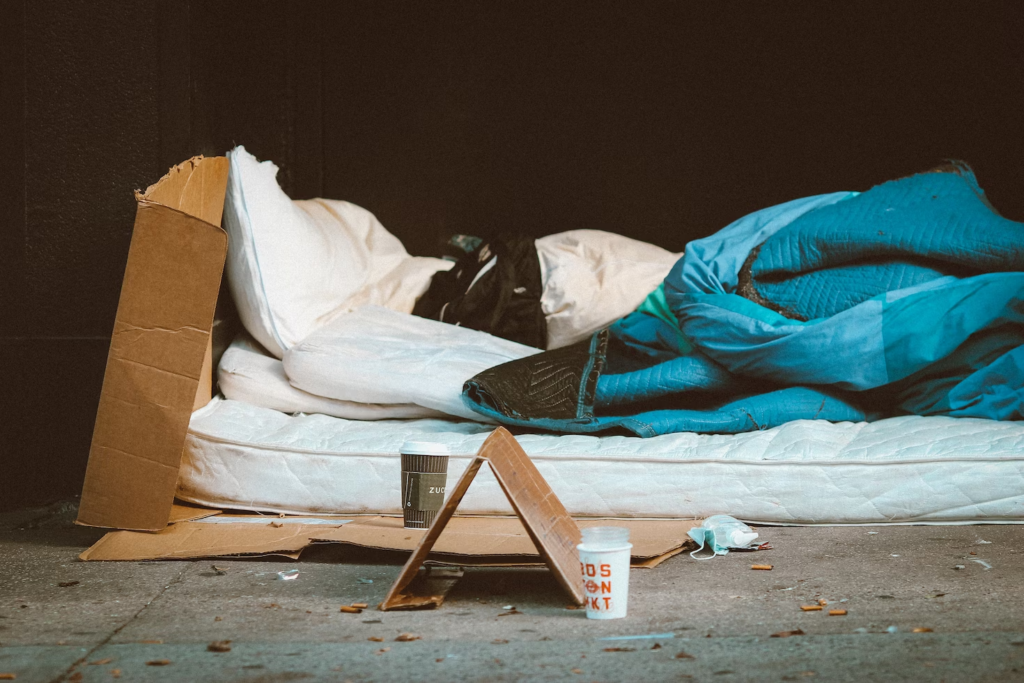It is the pandemic and its aftermath again. And this time, the picture is even more concerning than we can imagine. The U.S has been grappling with an increased rate of homelessness ever since the plague ended. Two years after the pandemic subsided, so did the aid that people were given, and homelessness in cities and states in the U.S have risen at alarming rates. It has become a pressing issue that affects numerous cities and diverse racial and ethnic groups throughout the nation. In 2022, approximately 18 out of every 10,000 U.S. residents experienced homelessness (as reported in the 2023 “State of Homelessness” report by the National Alliance to End Homelessness). The same report also highlights that the leading causes of homelessness in the U.S. are a shortage of affordable housing, low income, unemployment, physical and mental health challenges, and domestic violence.
These statistics have created a deep rooted anxiety in most citizens. Because while at any given time, a rough number of half a million Americans are victims of homelessness, many millions more are on the verge of losing the places that they live in. Thus giving way to major housing insecurities. And few of the main reasons are unaffordable housing, fear of being evicted without notice and the housing shortage.
The current situation looks bleak.
Mike Jon: a veteran and a restaurant worker in Ohio, in sharing his troubled state with Spectrum News (in an article titled, “Data suggests home insecurity increased ever since the pandemic” by Samana Sheikh) mentions how he is someone who was once a victim of homelessness and is reluctant to spill details about his past. However, he does raise concerns and valid fears about the housing insecurity that is haunting not just him, but the entire community of Ohio and America as a whole. The article quotes Jon, where he says:
“Everybody is just one step away from homelessness. All it takes is a shift in the market. You lose your employment, some trauma comes to you and you end up in a homeless state. Homelessness is the worst thing that could happen to someone”. And Jon’s is just one of many stories.

The affordable housing crisis in the United States has been a chronic issue since the Great Recession and has only worsened over time. In 2022, it was estimated that the U.S. needed approximately four to five million more homes in the market than what was available during the time. Housing costs have become increasingly unmanageable for both renters and potential buyers, with over 40% of renters experiencing cost burdens, meaning they spend more than 30% of their income on housing expenses. Furthermore, housing prices are rising at a faster rate than wage growth in 80% of U.S. markets.
The situation has been further complicated by factors such as the surge in remote work and supply chain disruptions caused by the COVID-19 pandemic. The shift to remote work led to increased demand for housing in suburban areas, while supply was constrained due to shortages of labor and building materials. These factors have combined to create a challenging housing market in the United States.
In California alone, the projected number of houses that would be required to tackle at least half of the housing shortage issue is 3.5 million homes. This number isn’t just a statistic about homes and property; it represents the stark reality of families, individuals, and communities in California struggling to find affordable shelter. ABC News draws data from a study released by the University of California, San Francisco to give an accurate image of California’s situation via numbers. The representative survey of nearly 3200 homeless people was done in order to figure out what led to these people losing a place to call home and what hindered their attempt at securing permanent housing. The research found that, when individuals lost their housing, their median household income was $960 per month. For renters who were on leases, their median household income was $1,400 per month, and on average, half of that income was allocated towards paying rent. This serves as a stark reminder of the immense challenge facing the state in the near future, demanding the attention of policymakers, investors, and urban planners. It symbolizes the impending housing crisis that looms over California and calls for immediate, well-informed, and specific strategies to alleviate the shortage. In simple terms, it is vital to address the elephant in the room which is the underlying problem of high rent and limited options.
This issue is not limited to just one region or one community. It has left no stone unturned and no person unscathed. The lack of stable housing is affecting college students and their futures as well. A large number of college students who go through housing insecurity and homelessness in the U.S have had to sacrifice their dreams of pursuing higher education. The question that constantly weighed on their mind was, without stable housing, how do we afford the luxury of attending a college? A national survey that was done in 2020 illustrated how close to half of all college students experienced housing insecurity. The numbers have possibly surged now, to the point where even thinking about the state of such students is disheartening. And if things were not bad enough already, there is a post-pandemic surge in evictions which adds to the layers of housing insecurities.
The main reason behind the increase in eviction rates is the removal of renter protection measures passed during the COVID-19 pandemic. As federal assistance abruptly halted the benefits, the fate of renters was transferred to the jurisdiction of state and local governments. According to numbers calculated by The Eviction Lab (an organization that monitors eviction cases in nearly 30 cities and 10 states) at Princeton University: the nation’s largest eviction database, when comparing the years 2020 and 2021, there has been an increase of 78%. Statistics mentioned by AP News in an article titled, “Eviction filings are 50% higher than they were pre-pandemic in some cities as rents rise” show how in certain cities, eviction filings have surged to levels more than 50% above what they were before the COVID-19 pandemic. Landlords initiate approximately 3.6 million eviction proceedings each year.

Some of the cities experiencing the most significant increases in eviction filings are Houston; where eviction rates were 56% higher in April and 50% higher in May, Minneapolis/St. Paul; which saw a 106% increase in eviction filings in March, followed by a 55% rise in April and a 63% increase in May, Nashville; where eviction rates were 35% higher in May, Phoenix; with a 33% increase in May and Rhode Island; which experienced a 32% increase in May. However, the housing insecurity caused by such drastic measures is not experienced equally by all Americans, but rather non-white tenants and tenants with families are the ones who are having it worse.
Having a roof above one’s head is a basic need that every human being should have the freedom to experience. It is not a luxury nor is it a privilege. Rising rents, unaffordable housing, housing shortages, eviction threats; none of these are individual or personal problems that have the right to affect them adversely. Living under a constant fear of losing their homes and grappling with the looming threat of housing insecurity is not how anybody should live. Therefore it is vital that the country looks into systemic and social reforms, ones that will address the situation rather than ones that will shame and penalize the tenants.
(Sandunlekha Ekanayake)
